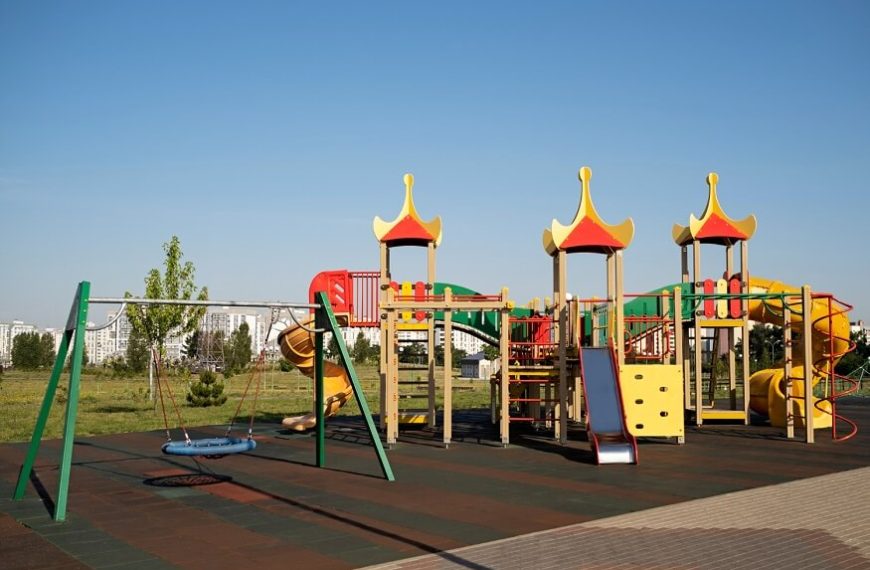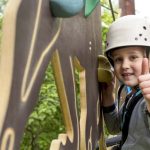In the era of digital screens, cultivating a profound connection between preschoolers and the great outdoors has never been more vital. Natural playgrounds stand as veritable havens where children can revel in the joy of unbridled play, fostering a holistic development that extends beyond physical prowess. Within this article, we embark on a journey to explore uncomplicated yet impactful ideas tailored specifically for preschool environments.
Understanding the significance of natural playgrounds is paramount before delving into the creative realm they offer. These playgrounds transcend mere physical activity, playing a pivotal role in shaping cognitive, social, and emotional facets of a child’s growth. From honing motor skills on log balance beams to sparking creativity in mud kitchens, natural playgrounds serve as dynamic canvases where preschoolers can explore, imagine, and forge connections with the natural world.
As we delve into these ideas, we unravel a tapestry designed to nurture the curious minds and active spirits of preschoolers. The symbiotic relationship between nature and play unfolds, showcasing how simple additions like butterfly gardens, tree stump seating, and storytelling circles can cultivate an environment where children not only thrive physically but also develop a profound appreciation for the beauty and wonders of the world around them.
The Importance of Natural Playgrounds for Preschoolers:
Before delving into the creative ideas, it’s crucial to understand why natural playgrounds are beneficial for preschoolers. The benefits extend beyond physical health and encompass cognitive, social, and emotional development.
- Physical Development:
Natural playgrounds provide opportunities for various physical activities that contribute to the overall development of motor skills, coordination, and balance. Climbing on natural structures, balancing on uneven surfaces, and swinging from tree branches all contribute to the enhancement of gross and fine motor skills.
- Cognitive Development:
Outdoor play in natural settings stimulates cognitive development. Children discover and negotiate the natural world while using critical thinking, problem-solving, and decision-making skills. In addition to inspiring youngsters to use their imaginations to make the area into anything they want, natural playgrounds also foster creativity.
- Social and Emotional Development:
Interacting with peers in a natural playground setting promotes social skills such as cooperation, communication, and conflict resolution. The unstructured nature of natural play areas allows children to explore their emotions and develop resilience as they encounter challenges in the outdoor environment.
- Connection with Nature:
For children to develop holistically, they must be exposed to nature. Natural playgrounds provide a link between kids and the environment, encouraging early environmental responsibility and cultivating a love of the natural world.
Designing Simple Natural Playgrounds for Preschoolers:
Now, let’s explore some simple yet effective ideas for creating natural playgrounds that cater specifically to the needs and interests of preschoolers.
- Mud Kitchen:
Transform an area with a few old pots, pans, and utensils into a mud kitchen. This allows children to engage in sensory play, exploring the textures of mud and sand. It also encourages imaginative play as they “cook” and “bake” with natural materials.
- Log Balance Beam:
Arrange logs of varying heights and widths to create a balance beam. This simple addition enhances children’s balance and coordination while providing a natural and rustic element to the playground.
- Tree Stump Seating:
Utilize tree stumps as natural seating arrangements. These can serve as gathering spots for storytelling sessions, group activities, or simply a place for children to rest and observe their surroundings.
- Hollow Logs and Tunnels:
Place hollow logs or tunnels made of natural materials for children to crawl through. This adds an element of adventure to the playground, stimulating both physical and imaginative play.
- Natural Sand Pit:
Integrate a sand pit filled with natural sand. This provides a sensory experience for children as they dig, build, and explore. Incorporate shovels, buckets, and molds to enhance the play experience.
- Butterfly and Flower Garden:
Make a little flower and butterfly garden with safe, non-toxic plants for kids. This not only makes the playground more attractive, but it also teaches kids about the natural world and the butterfly’s life cycle.
- Nature Art Station:
Set up an art station with easels and natural materials such as leaves, twigs, and flowers. Children can use these materials to create unique artwork, fostering creativity and a connection with the environment.
- Storytelling Circle:
Designate a circular area with logs or stones for storytelling. This becomes a communal space where teachers or children can share stories, fostering language development and a sense of community.
- Bird Feeders and Houses:
Hang bird feeders and birdhouses in strategic locations. This not only attracts birds, providing an opportunity for observation, but also teaches children about the importance of caring for other living creatures.
- Natural Water Play:
Incorporate a shallow water feature, such as a small stream or pond, with appropriate safety measures. This allows children to engage in water play, enhancing sensory experiences and understanding of water properties.
- Ensuring Safety and Sustainability:
While designing natural playgrounds, it’s crucial to prioritize safety and sustainability. Make use of naturally occurring materials that are safe and devoid of dangerous compounds. Make sure that all of the structures on the playground are age-appropriate, and do routine checks for any possible risks. Additionally, involve children in the maintenance and care of the natural elements to instill a sense of responsibility and environmental stewardship.
Expanding the Exploration of Natural Playground Ideas for Preschoolers:
As we dive deeper into the realm of natural playgrounds for preschoolers, it becomes increasingly apparent that the benefits extend far beyond the surface. These spaces become transformative landscapes, shaping the foundational experiences that contribute to a child’s cognitive, emotional, and social development.
- Natural Music Wall:
Introduce a music wall made from natural materials, such as wooden planks, pots, and pans. This not only engages children in sensory exploration but also encourages them to create rhythmic sounds, promoting auditory development and a sense of creativity.
- Rock and Pebble Pathways:
Design pathways using rocks and pebbles, stimulating tactile experiences as children walk barefoot. This not only enhances sensory perception but also promotes a connection with the earth beneath their feet.
- Animal Track Impressions:
Create impressions of animal tracks in designated areas using molds or cutouts. This activity not only sparks curiosity about wildlife but also facilitates learning about different animals and their habitats.
- Nature’s Scavenger Hunt:
Organize scavenger hunts using natural items like pinecones, leaves, and feathers. This activity encourages observational skills, teamwork, and an appreciation for the diversity of the natural environment.
- Rainbow Garden:
Plant flowers of various colors in a designated rainbow pattern. This not only adds a vibrant aesthetic to the playground but also serves as a visual learning tool for colors.
- Outdoor Reading Nook:
Create a cozy reading nook with natural materials like logs, tree stumps, and soft cushions. This provides a tranquil space where children can immerse themselves in books and stories, fostering a love for reading.
- Sensory Nature Trail:
Develop a sensory trail using different textures like grass, sand, and bark. This encourages children to explore the diverse sensations beneath their feet, promoting sensory development and awareness.
- Nature-inspired Obstacle Course:
Construct a simple obstacle course using natural elements like logs, tree branches, and boulders. This enhances gross motor skills, coordination, and problem-solving as children navigate through the course.
- Giant Nest Building:
Provide materials such as twigs, leaves, and branches for children to construct giant bird nests. This collaborative activity not only encourages teamwork but also introduces concepts related to animal habitats.
- Reflective Pond:
Create a reflective pond using a shallow container filled with water and floating flowers. This not only adds an element of tranquility but also provides an opportunity for children to observe reflections and learn about water ecosystems.
Fostering Learning Through Play:
Natural playgrounds inherently serve as dynamic classrooms where children learn through hands-on experiences. These environments offer numerous opportunities for integrating educational concepts seamlessly into play, promoting a love for learning.
Language Development:
Incorporate sign boards with names of plants, animals, or natural features in the playground. This encourages language development as children read and discuss these elements during their play.
Mathematics Exploration:
Utilize natural materials for counting activities. For instance, arrange pinecones in numerical order or create shapes using sticks, fostering an early understanding of mathematical concepts.
Science Inquiry:
Encourage curiosity through simple science experiments. For example, observe the growth of plants, study insects, or explore the concept of sink and float in the water play area.
Cultural and Social Understanding:
Introduce elements from diverse cultures in the playground design. This could include themed areas or structures that represent different cultures, fostering cultural awareness and social understanding.
Sustainability in Natural Playground Design:
An integral aspect of natural playgrounds is their sustainability. Incorporating eco-friendly practices not only aligns with the principles of environmental stewardship but also imparts valuable lessons to the young minds engaging with these spaces.
Native Plant Landscaping:
Opt for native plants in landscaping. These plants are well-adapted to the local environment, requiring less maintenance and contributing to biodiversity.
Rainwater Harvesting:
Implement rainwater harvesting systems to water plants in the playground. This sustainable practice not only conserves water but also teaches children about the importance of responsible resource use.
Recycled Materials:
Integrate recycled materials into the playground design. This not only reduces waste but also serves as an educational tool, demonstrating the possibilities of repurposing materials.
Community Involvement:
Engage the community in the maintenance and development of the natural playground. This fosters a sense of collective responsibility and strengthens the bond between the preschool and the surrounding community.
Overcoming Challenges and Embracing the Benefits:
While the concept of natural playgrounds is inherently appealing, there are practical considerations and challenges that need to be addressed to ensure the success of these spaces.
Safety Measures:
Prioritize safety by conducting regular inspections of the playground equipment and natural elements. Ensure that the materials used are child-safe and free from potential hazards.
Inclusive Design:
Strive for inclusivity in design to accommodate children of diverse abilities. This may involve creating wheelchair-accessible paths, incorporating sensory elements, and providing seating options suitable for all children.
Educator Training:
Offer training for educators to effectively utilize the natural playground as an extension of the classroom. This ensures that teachers can guide and facilitate learning experiences within the outdoor environment.
Parent and Community Engagement:
Encourage parent and community involvement in the natural playground. This collaboration fosters a sense of shared responsibility and strengthens the support network for the preschool.
Weather Considerations:
Develop strategies for utilizing the natural playground in various weather conditions. This may involve providing shade in sunny areas, creating covered spaces, or ensuring proper drainage during rainy periods.
The Lasting Impact of Natural Playgrounds:
Upon contemplating the manifold advantages, architectural factors, and pedagogical possibilities of natural playgrounds for young children, it is apparent that these areas are not just leisurely but also transformational. The play has a profound effect that goes far beyond the momentary happiness it brings; it builds a foundation for a child’s lifetime relationship with nature, enjoyment of learning, and acquisition of lasting skills.
In essence, natural playgrounds become the canvas upon which the vivid tapestry of a child’s growth is painted. These are places where the sound of laughing combines with the rustling of leaves, where curiosity and flowery scents merge, and where playing turns into an insightful voyage of discovery. In addition to creating stimulating surroundings for young children, educators, parents, and communities that support the idea of natural playgrounds are planting the seeds for a future generation that will be profoundly ingrained with a love of learning, creativity, and the natural world.
In conclusion, simple natural playgrounds for preschoolers can provide a rich, engaging environment that contributes to their overall development. By incorporating elements such as mud kitchens, log balance beams, and nature art stations, educators and parents can create spaces that encourage exploration, imagination, and connection with the natural world. These playgrounds not only foster physical skills but also support cognitive, social, and emotional development, laying the foundation for a lifelong love of outdoor play and nature.
For more such interesting blogs, Visit EuroKids
















